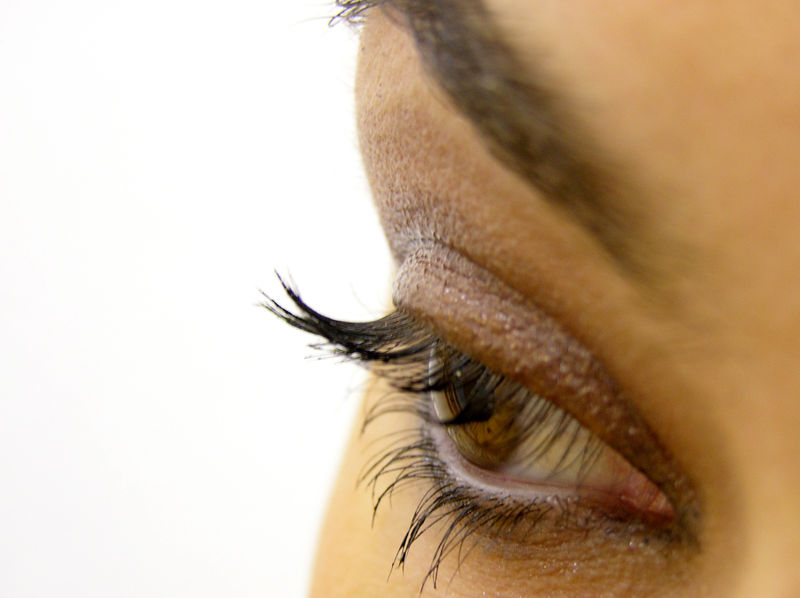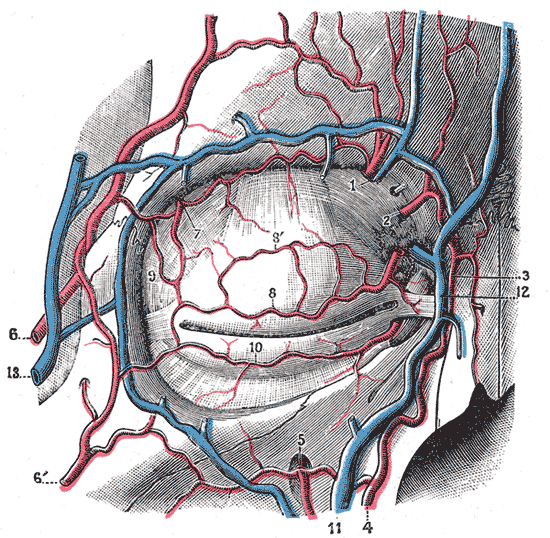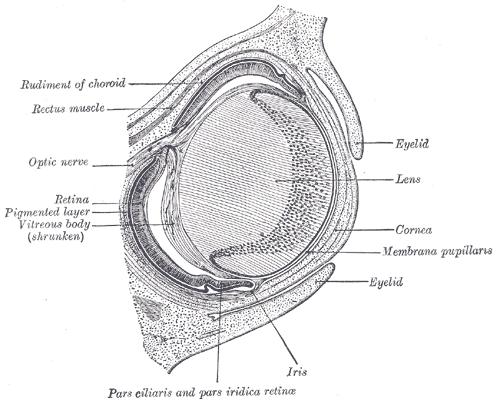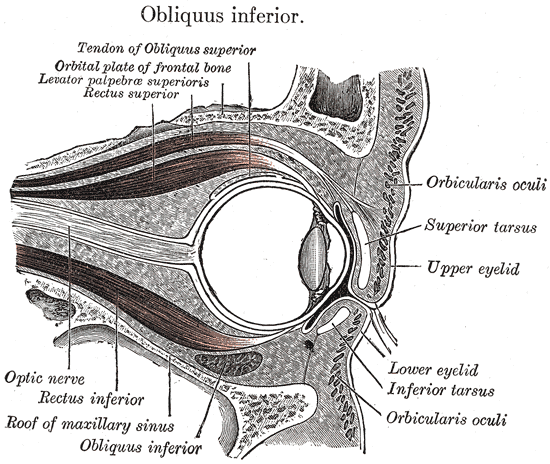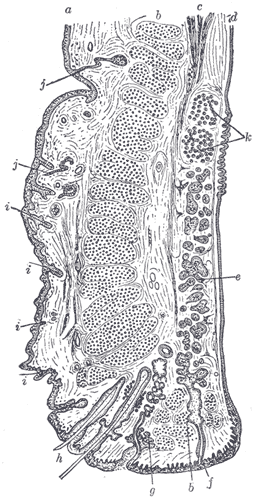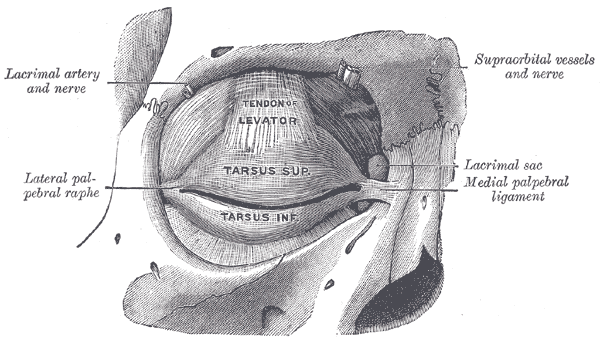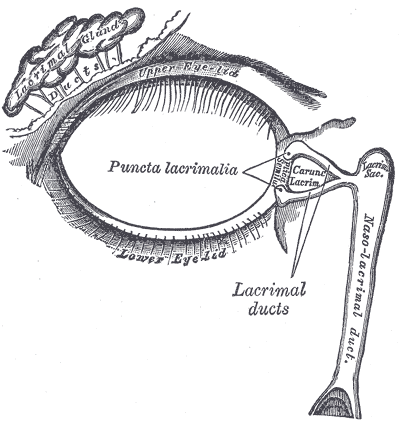Eyelid
Template:Infobox Anatomy Editor-In-Chief: C. Michael Gibson, M.S., M.D. [1]
Overview
An eyelid is a thin fold of skin that covers and protects an eye. With the exception of the prepuce and the labia minora, it has the thinnest skin of the whole body. The levator palpebrae superioris muscle retracts the eyelid to "open" the eye. This can be either voluntarily or involuntarily. The human eyelid features a row of eyelashes which serve to heighten the protection of the eye from dust and foreign debris. "Palpebral" (and "blepharo") means relating to the eyelids.
Anatomy
Layers
In the human eyelid, there are various layers; from superficial to deep, they are: skin, subcutaneous tissue, orbicularis oculi, orbital septum & tarsal plates, and palpebral conjunctiva. The meibomian glands lie within the eyelid and secrete the lipid part of the tearfilm.
Skin
The skin is similar to areas elsewhere, but have more pigment cells. In diseased persons these may wander and cause a discoloration of the lids. It contains sweat glands and hairs, the latter becoming eyelashes as the border of the eyelid is met. [1]
Innervation
In humans, the sensory nerve supply to the upper eyelids is from the infratrochlear, supratrochlear, supraorbital and the lacrimal nerves from the ophthalmic branch (V1) of the trigeminal nerve (CN V). The skin of the lower eyelid is supplied by branches of the infratrochlear at the medial angle, the rest is supplied by branches of the infraorbital nerve of the maxillary branch (V2) of the trigeminal nerve.
Blood supply
In humans, the eyelids are supplied by two arches on each upper and lower lid. The arches are formed by anastamoses of the lateral palpebral arteries and medial palpebral arteries, branching off from the lacrimal artery and ophthalmic artery, respectively.
Muscles besides the Orbicularis oculi
Involuntary muscle fibers controlled by the sympathetic autonomic nervous system and open the eyelids away from each other, widening the eye aperture. The corrugator supercilii helps shield the eye from sun glare by pulling the eyebrow toward the bridge of the nose making a "roof" over the medial side of the eye and typical furrows in the forehead. The procerus muscle, on the bridge of the nose, fold the skin into tranmsverse furrows. The Frontalis lifts the eyebrows (thus opposing the orbital portion of the orbicularis), especially when looking up. It also acts when a view is too distant or dim.[2]
Usage
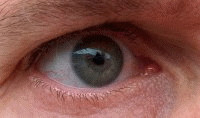
When an eye becomes dry, "blinking" – closing the eyelid and opening it again rapidly – can help to spread moisture across the surface of the eye and ease the discomfort. Blinking also serves the purpose of helping to remove irritants which have landed in the eye. When a person chooses to blink one eye as a signal to another in a social setting, it is known as "winking."
Most animals with eyelids have a reflex to close the eyes when a threat comes too near. This is done involuntarily to protect the eye from contact with the threat. It is often strong enough to overcome any voluntary resistance.
Eyelids also serve the purpose of helping the animal to control the amount of light entering the eye (control of the iris is autonomic). Without eyelids, many animals would be helpless to block visual sensory overload under very bright light. Many animals also use eyelids to block light from reaching the eyes during sleeping cycles.
Types
In humans, each eye has an upper and lower eyelid which operate as a pair, however, it is primarily the upper eyelid that moves across the exposed surface of the eye during blinking. Lower eyelids in most animals move vertically.
Many terrestrial vertebrates have an eyelid known as a nictitating membrane, or haw. This eyelid is closer to the eye than the outer lids and is usually transparent. The purpose of the nictitating membrane is to add protection to the eye from debris and irritation, and in land animals it also serves as a barrier while swimming. Camels, crocodiles, cats, birds, and polar bears are among animals that have this membrane. The nictitating membrane sweeps across the eye diagonally or horizontally. In humans, the plica semilunaris (or semilunar fold) is thought to be the vestigial remnant of the nictitating membrane.
It has been suggested that eyelids evolved as a way to remove debris from the eyes. Given that fish have a constant stream of water flowing over their eyes, it is not surprising that they do not have eyelids or need specialized membranes to perform this function.
Double eyelid
A double eyelid is a type of eyelid where a crease exists. In contrast, a single eyelid has no crease. There is a wide variation in the location of the crease, particularly in the Asian double eyelid.
Death
After death, it is common in many cultures to pull the eyelids of the deceased down to close the eyes. This a typical part of the last offices.
See also
Disorders
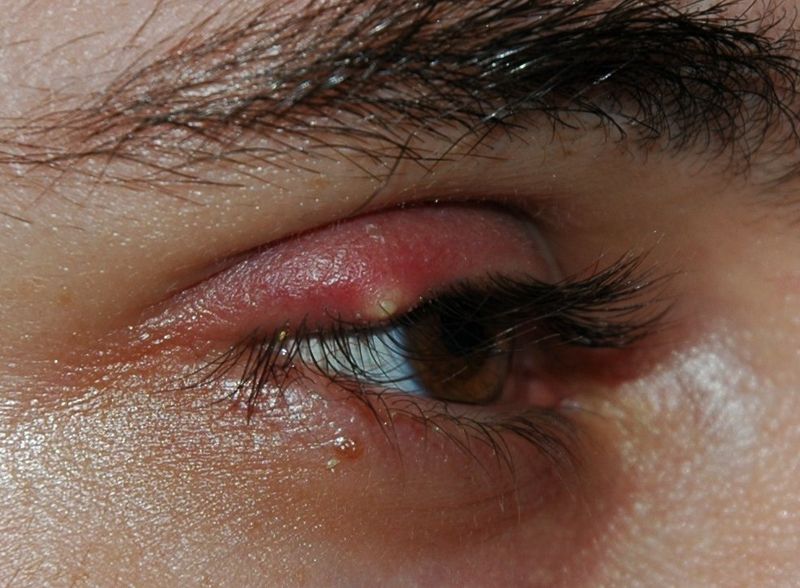
- Blepharospasm
- Cellulitis
- Chalazion
- Dermatochalasis
- Ectropion
- Entropion
- Hay-Wells syndrome
- Ptosis
- Stye (Hordeolum)
Surgeries
Additional images
-
Eye makeup
-
Bloodvessels of the eyelids, front view.
-
Horizontal section through the eye of an eighteen days’ embryo rabbit. X 30.
-
Sagittal section of right orbital cavity.
-
Sagittal section through the upper eyelid.
-
The tarsi and their ligaments. Right eye; front view.
-
The lacrimal apparatus. Right side.
References
Template:Accessory organs of the eye
bn:পলক (চোখ) bg:Клепач de:Augenlid eo:Palpebro eu:Betazal id:Kelopak mata it:Palpebra he:עפעף la:Palpebra lt:Vokas nl:Ooglid fi:Silmäluomi sv:Ögonlock yi:אויגן לאד
